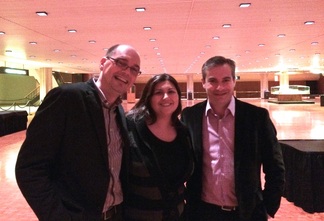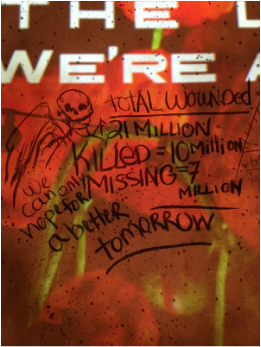
Marcus Keller, Michelle Salerno, and Michael Rothberg
When coordinators Michael Rothberg and Marcus Keller offered me the opportunity to work as the programming assistant on “The Great War: Experiences, Representations and Effects” I was eager to combine my experience in event planning with my dissertation research on the circulation of notions of race and citizenship in American theatre and performance during the First World War. The scale of the initiative quickly developed as our core projects were enhanced by upcoming events from all parts of the campus and the community. An impressive list of cross-campus sponsors, that continued to grow over the semester, helped to support and publicize lectures, symposiums, exhibits, performances, films, and courses to foster a continuing dialogue about the war and its influence. For me, as I’m sure it was for many others, it was a true privilege to be immersed in the themes, topics, and questions raised throughout the fall and we hope to continue to encourage this dialogue.

Performance of "Mine Eyes Have Seen"
Highlights of the Initiative
In considering the numerous events of the project, it is important to note the work of students, both undergraduate and graduate, in the initiative. In connection with the Illinois Theatre production of Oh What a Lovely War, the department’s programming committee helped to organize “Then and Now: Theatre and Performance of The Great War.” The program included a reading of Alice Dunbar Nelson’s Mine Eyes Have Seen (1918) performed by actors from the MFA and BFA Acting and Theatre Studies programs, theatre minors, non-theatre students from across disciplines, and a community member. The play is a key component of my dissertation and the chance to share this rarely performed work was an incredible opportunity. Following the performance, several Theatre Studies doctoral students presented papers on 21st century responses to the war including graphic novels, video games, and twitter war re-enactment.
Mine Eyes Have Seen offers a look at an African American family on the day they discover their youngest brother has been drafted. They debate, with their Jewish and Irish neighbors, if they are willing to contribute to the war effort on behalf of a country that allows lynch mobs and vigilante violence, racism, and segregation. The characters’ arguments for and against participating in the war profoundly resonated with current protests articulating the violence of institutional racism and the frequent disconnect between the rhetoric of nationalism and inclusion and the lived experiences of minority citizenship. Through directing and presenting the reading, my own understanding of the play expanded in innumerable ways thanks to the diligent work of the actors and the thoughtful feedback of the audience. In addition, the graduate students of “The Great War: Transnational Literary Response” reading group concluded their semester of meetings by discussing the play and offering comparative insights to the British and Irish literature they read for previous meetings. This group also worked with the English Student Council to organize a “Literature and War” event with readings of poetry and drama and the performance of live music.
There were also numerous undergraduate students who encountered events on the First World War through their courses. The core course World War I and the Making of the Global Twentieth Century, offered by Tamara Chaplin and Peter Fritzsche from the History department, delved deeply into the complexity of the war and its commemoration, and many of these students attended initiative events. In addition, we also know of other courses with World War I content or classes that required, requested, or encouraged their students to attend particular events or exhibits to enhance classroom discussions. The IPRH “Inside Scoop” undergraduate event, with Lessons from Sarajevo author James Hicks, was particularly popular and facilitated a remarkable conversation about literature and war within the group.

Scenery from "Oh What a Lovely War"
One of my favorite moments came in the final minutes of Oh What a Lovely War, a highly immersive theatre experience, when the relationship between the actors and the audience abruptly shifted in an extraordinary way. Since the department has chosen to remount the production in late February, I’ll refrain from divulging specifics, but I will note that the shift asks the audience to contextualize the First World War as part of a continuum of warfare through the sharing of personal history. Just as the Vietnam War ghosted the play when Joan Littlewood and her Theatre Workshop first produced it in 1963, Robert Anderson’s production does not allow the audience to disconnect the First World War from our current moment. Instead, participants are encouraged to think through the complexities of war, violence, sacrifice, nationhood, citizenship, and personal history as a means to a deeper understanding of the continual making and re-making of history.
The Great War Commemoration that Surrounds Us
 "The Great War: Experiences, Representations and Effects” was just a small contribution to the global recognition of the 100th anniversary of the start of the war including such responses as the beautifully somber 888,246 ceramic poppies that overwhelmed the Tower of London in Blood Swept Lands and Seas of Red, each standing for a British military fatality during the war. Research trips to other exhibits and events across the country have given me the opportunity to see how many American institutions examine the commemoration of the war. I highly recommend the National World War I Museum in Kansas City, MO that offers extensive collections on the war from a variety of perspectives and includes exhibits on its particular resonance in the Midwest. This museum also served as the primary American locus for the commemoration of the 100th anniversary of the assassination of the Archduke Franz Ferdinand, hosting a large scale Twitter re-enactment of the event discussed by Theatre doctoral student BJ Gailey in “Acting is Reenacting: Twitter, Archduke Ferdinand, and the Performance of History” in the aforementioned panel. College students from the University of Kansas and members of the Kansas City community are still tweeting as historical First World War characters so you can continue to watch the story unfold by following @KU_WW1 on Twitter.
"The Great War: Experiences, Representations and Effects” was just a small contribution to the global recognition of the 100th anniversary of the start of the war including such responses as the beautifully somber 888,246 ceramic poppies that overwhelmed the Tower of London in Blood Swept Lands and Seas of Red, each standing for a British military fatality during the war. Research trips to other exhibits and events across the country have given me the opportunity to see how many American institutions examine the commemoration of the war. I highly recommend the National World War I Museum in Kansas City, MO that offers extensive collections on the war from a variety of perspectives and includes exhibits on its particular resonance in the Midwest. This museum also served as the primary American locus for the commemoration of the 100th anniversary of the assassination of the Archduke Franz Ferdinand, hosting a large scale Twitter re-enactment of the event discussed by Theatre doctoral student BJ Gailey in “Acting is Reenacting: Twitter, Archduke Ferdinand, and the Performance of History” in the aforementioned panel. College students from the University of Kansas and members of the Kansas City community are still tweeting as historical First World War characters so you can continue to watch the story unfold by following @KU_WW1 on Twitter.

I was also able to visit The Huntington Library’s “Posters of the First World War,” which drew from the library’s collection of prints and ephemera, demonstrating how the graphic arts can be utilized as propaganda. The exhibit offered the ability to see both American and European posters, allowing attendees to compare how their messages were conveyed.
In fact, propaganda posters were the most prominent feature of the exhibits I’ve seen this summer and fall including our own “La Grande Guerre: French Posters and Photographs from World War I” at the Krannert Art Museum.

The museum shop at the National World War I Museum sells reproductions of many of these posters including a “Destroy This Mad Brute” iPhone cover based on the notorious anti-German propaganda poster (a horrifying and tempting item for a researcher writing about race and enemization during the war). Even our own Classic Home Consignment store in Champaign has been selling World War I propaganda posters and I’ve been told they’ve sold quite a few already.

Opening Night, "La Grande Guerre"
These examples demonstrate an interest in First World War content that I hope to see extending at least through the next few years. Although we had intended our initiative to conclude at the end of fall term, it became clear that there was momentum to continue updating our website and social media with local events and performances happening throughout the spring; instead of being at the end, we’re just a little closer to the end. So keep checking our website (http://www.thegreatwar.illinois.edu), following us on Facebook and Twitter, and contact us if you’re planning an event this spring with World War I content. We’re eager to continue the conversation and we hope you are as well.

